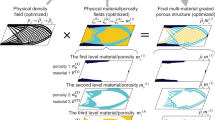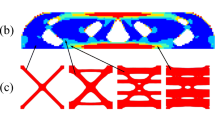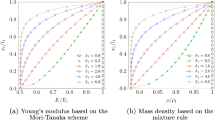Abstract
Functionally gradient materials (FGM) widely exist in biological structures, which offer indispensable support and potential protection. In this paper, we expand topology optimization for coated-base materials to multi-gradient structure. In the process of modeling the biological bones, we define three levels of density gradients: a spongy bone as the base in between, wrapped by a layer of compact bone, and multi-layers of periosteum side by side. By defining the properties and thickness of each layer, the base domain is derived by the gradient norm while a modified non-monotone filter function is imposed to separate periosteum and compact bone. Meanwhile, periosteum is separated into multi-gradient layers by Heaviside projection function in order to further mimic the skeletal of bone structure. The method of robust control, using geometric constraints, is applied to the design domain in both solid and void phases to avoid local singularity during the optimal process. Finally, the validity of the algorithm is illustrated by two benchmark problems with a variety of layer combinations.




















Similar content being viewed by others
References
Al-Shamary A, Karakuzu R, Özdemir O (2016) Low-velocity impact response of sandwich composites with different foam core configurations. J Sandw Struct Mater 18:754–768
Beaupré GS, Orr TE, Carter DR (1990) An approach for time-dependent bone modeling and remodeling–application: a preliminary remodeling simulation. J Orthop 8:662–670
Behrou R, Lawry M, Maute K (2017) Level set topology optimization of structural problems with interface cohesion. Internat J Numer Methods Engrg 112:990–1016
Bendsøe MP, Sigmund O (1999) Material interpolation schemes in topology optimization. Arch Appl Mech 69:635–654
Bendsøe MP, Sigmund O (2003) Topology optimization. Theory, methods and applications, Springer
Chu S, Xiao M, Gao L (2019) Topology optimization of multi-material structures with graded interfaces. Comput Methods Appl Mech Engrg 346:1096–1117
Clausen A, Aage N, Sigmund O (2015) Topology optimization of coated structures and material interface problems. Comput Methods Appl Mech Engrg 290:524–541
Clausen A, Aage N, Sigmund O (2016) Exploiting additive manufacturing infill in topology optimization for improved buckling load. Engineering 2:250–257
Clausen A, Andreassen E (2017) On filter boundary conditions in topology optimization. Struct Multidiscip Optim 56:1147–1155
Dumont E (2010) Bone density and the lightweight skeletons of birds. Proc Royal Soc B Bio Sci 277:2193–2198
Fischer KJ, Jacobs CR, Levenston ME (1997) Observation of convergence and uniqueness of node-based bone remodeling simulations. Ann Biomech Eng 25:261–268
Groen J, Wu J, Sigmund O (2019) Homogenization-based stiffness optimization and projection of 2D coated structures with orthotropic infill. Comput Methods Appl Mech Engrg 349:722–742
Hägg L, Wadro E (2018) On minimum length scale control in density based topology optimization. Struct Multidiscip Optim 58:1015–1032
Hashin Z, Shtrikman S (1963) A variational approach to the theory of the elastic behaviour of multiphase materials. Journal of the Mechanics and Physics of Solids 11:127–140
Hoang V, Nguyen N, Nguyen H (2019) Topology optimization of coated structure using moving morphable sandwich bars. Struct Multidiscip Optim 61:419–506
Kawamoto A, Matsumori T, Yamasaki S (2011) Heaviside projection based topology optimization by a PDE-filtered scalar function. Struct Multidiscip Optim 44:19–24
Lazarov BS, Sigmund O (2011) Filters in topology optimization based on Helmholtz-type differential equations. Int J Numer Methods Eng 86:765–781
Lazarov B, Wang F (2017) Maximum length scale in density based topology optimization. Comput Methods Appl Mech Engrg 318:826–844
Luo Y, Li Q, Liu S (2019) A projection-based method for topology optimization of structures with graded surfaces. Int J Numer Methods Eng 118:654–677
Naebe M, Shirvanimoghaddam K (2016) Functionally graded materials: a review of fabrication and properties. Appl Mater Today 5:223–245
Pack PE (2001) Anatomy and physiology, Hungry Minds INC, USA
Petrudi A, Rahmani M (2020) Numerical and analytical study of fatigue and degradation in multilayer composite plates. Rev des Compos et des Mater Av 30:61–68
Rice JC, Cowin SC, Bowman JA (1988) On the dependence of the elasticity and strength of compact bone on apparent density. Biomechanics 155–168:21
Sarathchandra D (2016) Functionally graded materials and processing techniques ICSEM. https://doi.org/10.1016/j.matpr.2018.06.536
Schevenels M, Sigmund O (2016) On the implementation and effectiveness of morphological close-open and open-close filters for topology optimization. Struct Multidiscip Optim 54:15–21
Sullivan T, Wang B, Espinosa H (2017) Extreme lightweight structures: avian feathers and bones. Mater Today 20:377–391
Svanberg K (1986) The method of moving asymptotes—a new method for structural optimization. Int J Numer Methods Eng 24:359–373
Vermaak N, Michailidis G, Parry G (2014) Material interface effects on the topology optimization of multi-phase structures using a level set method. Struct Multidiscip Optim 50:623–644
Vermaak N, Michailidis G, Parry G, Estevez R, Allaire G, Bréchet Y (2014) Material interface effects on the topology optimization of multi-phase structures using a level set method. Struct Multidiscip Optim 50:623–644
Wadbro E, Niu B (2019) Multiscale design for additive manufactured structures with solid coating and periodic infill pattern. Comput Methods Appl Mech Engrg 357:112605
Wang Y, Chen F, Wang M (2017) Concurrent design with connectable graded microstructures. Comput Methods Appl Mech Engrg 317:84–101
Wang Y, Kang Z (2018) A level set method for shape and topology optimization of coated structures, vol 329
Wang F, Lazarov O, Sigmund O (2010) On projection methods, convergence and robust formulations in topology optimization, vol 43
Wang B, Meyers M (2017) Seagull feather shaft: correlation between structure and mechanical response. Acta Biomater 48:270–288
Wu J, Clausen A, Sigmund O (2017) Minimum compliance topology optimization of shell–infill composites for additive manufacturing. Comput Methods Appl Mech Engrg 326:358–375
Xu F, Zhang X, Zhang H (2018) A review on functionally graded structures and materials for energy absorption. Eng Struct 171:309–325
Yoon G, Yi B (2019) A new coating filter of coated structure for topology optimization. Struct Multidiscip Optim 60:1527–1544
Zhang J, Qin Q, Chen S, et al. (2020) Low-velocity impact of multilayer sandwich beams with metal foam cores: analytical, experimental, and numerical investigations. J Sandw Struct Mater 22:626–657
Zhou M, Lazarov B, Wang F (2015) Minimum length scale in topology optimization by geometric constraints. Comput Methods Appl Mech Engrg 293:266–282
Zhu J, Zhang W, Xia L (2015) Topology optimization in aircraft and aerospace structures design. Arch Comput Methods Eng 23:595–622
Funding
This work is supported by the National Natural Science Foundation of China under Grant U1613225.
Author information
Authors and Affiliations
Corresponding author
Ethics declarations
Conflict of interest
The authors declare that they have no conflict of interest.
Additional information
Responsible Editor: Ole Sigmund
Replication of results
This paper proposed a bone-inspired multi-gradient material mode based on SIMP and several known filter methods, which is graphically proposed in Fig. 3. The result code is available as supplementary material for optimal structure in Fig. 12. Other results follow the optimal process and sensitivity analysis in Section 4.
Publisher’s note
Springer Nature remains neutral with regard to jurisdictional claims in published maps and institutional affiliations.
Rights and permissions
About this article
Cite this article
Dong, Y., Liu, X., Song, T. et al. Topology optimization for structure with multi-gradient materials. Struct Multidisc Optim 63, 1151–1167 (2021). https://doi.org/10.1007/s00158-020-02749-3
Received:
Revised:
Accepted:
Published:
Issue Date:
DOI: https://doi.org/10.1007/s00158-020-02749-3




